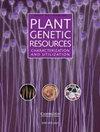希腊地方豌豆种的种皮和种门颜色与种子性状的关系
IF 0.7
4区 生物学
Q3 PLANT SCIENCES
Plant Genetic Resources: Characterization and Utilization
Pub Date : 2023-07-28
DOI:10.1017/s1479262123000527
引用次数: 0
摘要
豌豆地方品种可能具有遗传变异,可用于育种/选择新品种。在一个小粒豌豆地方品种中,根据种皮(绿色,无斑点和绿色,有斑点)和种门颜色(白色,黑色)区分了四种表型。在两个生长季节对四种表型的荚果(种子/荚果)和种子性状(千粒重、韧性、总酚类和单宁、种皮颜色、蛋白质和碳浓度、碳氮比、糙皮侵染)进行田间试验。结果表明,两种植物的颜色参数、酚类、单宁、碳浓度和耐糙性存在显著差异。种子较大、有斑点的豌豆有较深的皮色和更多的酚类物质,而白脐豌豆有较浅的皮色和更多的单宁。斑点型、黑顶型、碳浓度和碳氮比最高的品种对野蓟的耐受性最强。然而,对表型进行分组,斑点型和黑顶型都没有表现出比对应型更强的耐受性。总之,我们的研究结果表明,豌豆地方品种种子的表型变异揭示了种子性状的变异,这是可以利用的。由于种皮和门部颜色与特定的种子性状相关,因此它们可以单独或组合用作豌豆种子品质性状的生物标志物。需要测试更多的表型来巩固我们的发现。本文章由计算机程序翻译,如有差异,请以英文原文为准。
Testa and hilum colour associations with seed traits of a Greek field pea landrace
Pea landraces may hold genetic variation that can be exploitable in breeding/selecting new cultivars. In a small-seeded pea landrace, four phenotypes were distinguished according to testa (green, non-spotted and green, spotted) and hilum colour (white, black). The four phenotypes were tested for two growing seasons in the field for pod (seeds/pod) and seed traits (1000-seed weight, toughness, total phenols and tannins, testa colour, protein and carbon concentration, C/N ratio, bruchid infection). Significant differences were found for testa colour parameters, phenolic, tannin and carbon concentration and bruchid tolerance. The larger-seeded, spotted peas had darker testa and more phenols, while white-hilumed peas had lighter testa and more tannins. The spotted, black-hilumed phenotype, with the highest carbon concentration and C/N ratio was the most tolerant to bruchids. However, grouping the phenotypes, neither spotted nor black-hilumed ones showed to be more tolerant compared with their counterparts. Concluding, our results showed that phenotyping variation in seeds of a pea landrace revealed variation in seed traits, which could be exploitable. Since testa and hilum colour were associated with specific seed traits, they could, alone or in combination, be used as biomarkers of seed quality traits in pea. Testing of larger number of phenotypes is needed to solidify our findings.
求助全文
通过发布文献求助,成功后即可免费获取论文全文。
去求助
来源期刊

Plant Genetic Resources: Characterization and Utilization
Agricultural and Biological Sciences-Agronomy and Crop Science
CiteScore
2.80
自引率
0.00%
发文量
29
审稿时长
>12 weeks
期刊介绍:
Plant Genetic Resources is an international journal which provides a forum for describing the application of novel genomic technologies, as well as their integration with established techniques, towards the understanding of the genetic variation captured in both in situ and ex situ collections of crop and non-crop plants; and for the airing of wider issues relevant to plant germplasm conservation and utilisation. We particularly welcome multi-disciplinary approaches that incorporate both a technical and a socio-economic focus. Technical aspects can cover developments in technologies of potential or demonstrated relevance to the analysis of variation and diversity at the phenotypic and genotypic levels.
 求助内容:
求助内容: 应助结果提醒方式:
应助结果提醒方式:


